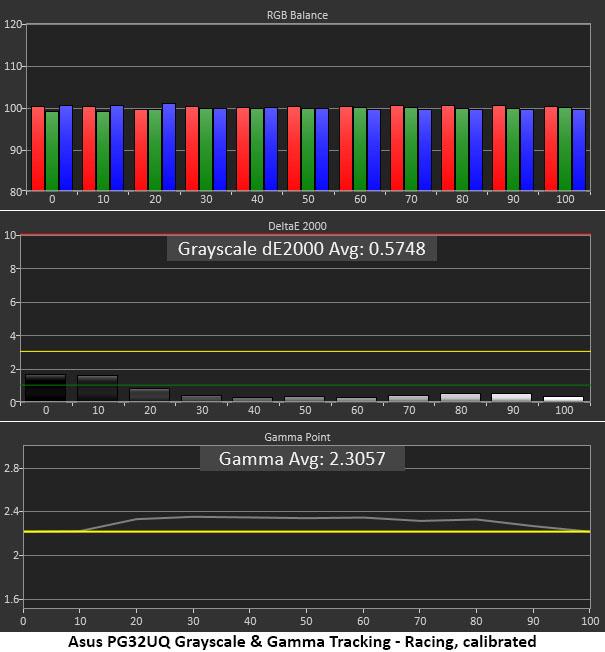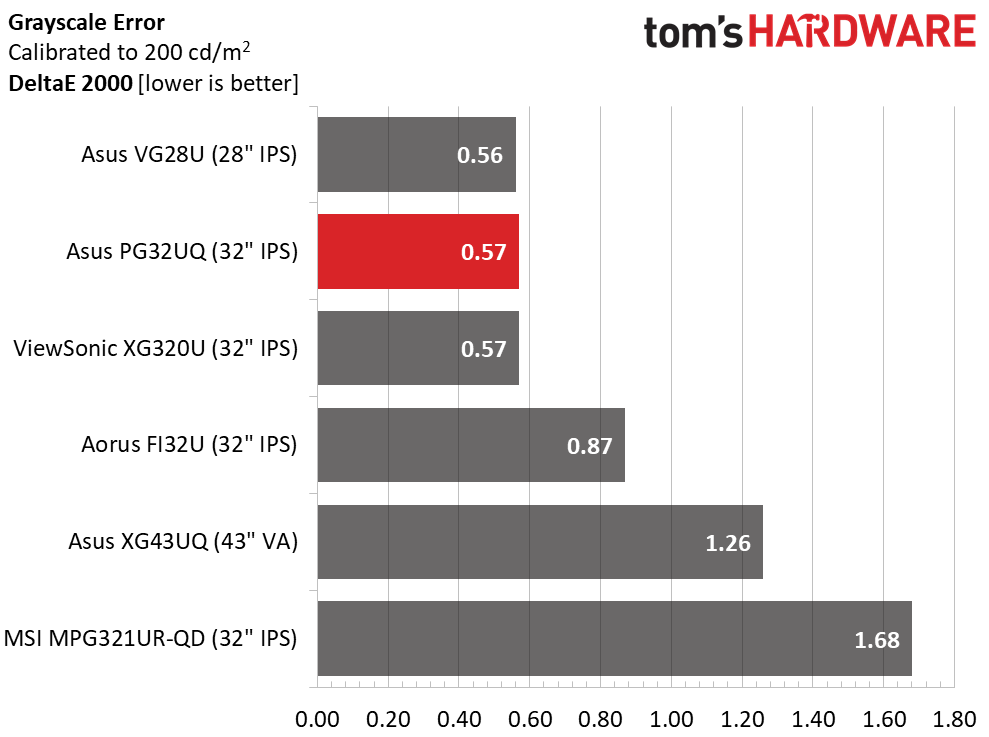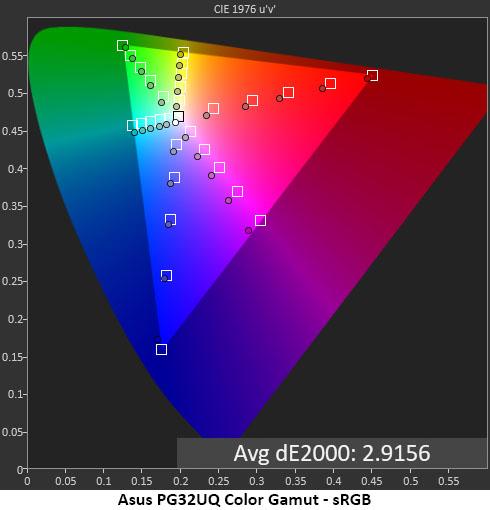Why you can trust Tom's Hardware
Like all Asus gaming monitors, the PG32UQ arrives in its Racing mode. It’s just accurate enough to use without calibration, but there are gains available. I did all my tests and gaming in this mode.
Grayscale and Gamma Tracking
Our grayscale and gamma tests use Calman calibration software from Portrait Displays. We describe our grayscale and gamma tests in detail here.



The PG32UQ’s default image is a little cool but good enough to impress without calibration. Blue errors are visible from 50% brightness and gamma is a tad light with a 2.13 average value.
Adjusting the RGB sliders removes all visible errors and takes the PG32UQ to reference level. This is equal to any professional monitor I’ve tested. I chose to set gamma on the 2.5 option which measures closer to 2.3. The picture has more depth and impact with a darker gamma value.
Comparisons




3.69dE is a reasonable default grayscale value for the PG32UQ. It sits mid-pack in this group of similarly priced screens. The MSI and ViewSonic panels are a little better out of the box, but calibration vaults the Asus into the top two. All the monitors have excellent grayscale tracking.
In terms of accuracy, gamma is about the same whether you leave the setting on 2.2 or go for 2.5 as I did. The deviation and range of values will be nearly identical. With that in mind, you can choose whichever setting you prefer and see an equally correct image. The darker gamma adds a bit more pop with deeper shadows and midtones.
Color Gamut Accuracy
Measuring the PG32UQ’s color gamut presented me with two options. Normally, I use DCI-P3 as a reference for extended color monitors. But the default hue values are closer to Rec.2020 so I used that reference instead. The results are below.
Get Tom's Hardware's best news and in-depth reviews, straight to your inbox.
Our color gamut and volume testing use Portrait Displays’ Calman software. For details on our color gamut testing and volume calculations, click here.




When using DCI-P3 as a reference, the PG32UQ has reasonably low errors with a 3.96dE average. But you can see in the first chart how off the green and red hues are. And the gamut is much larger. By switching the reference to Rec.2020, you can see what Asus is doing here. The goal is clearly Rec.2020 and the PG32UQ comes closer to achieving it than almost any other monitor I’ve tested. It comes up a little short, no surprise, but in practice, the color saturation is tremendous.
Calibration fixes the secondary hue errors in cyan and magenta, and puts most saturation points on their targets. The average error compared to the Rec.2020 standard is just 1.83dE and that is fantastic performance. The PG32UQ isn’t just colorful, it’s really colorful.
If you need an sRGB mode, Asus provides one, but it’s a little under-saturated in red with hue errors for cyan and magenta. The average error is just below the visible threshold, so I consider the mode usable for all but the most critical applications.
Comparisons


For the PG32UQ, I used Rec.2020 as a reference for its measured 1.83dE color error. The other screens are tested against DCI-P3. Though the MSI and ViewSonic screens have a tiny bit more color volume, their hue tracking suggests DCI-P3 rather than Rec.2020. In practice, all the monitors have tons of accurate and saturated color. Only the VG28U and FI32U could be called “average.” Any monitor with more than 90% DCI-P3 coverage will look very rich and vibrant. The PG32UQ is one of the best in this regard.
Current page: Grayscale, Gamma and Color
Prev Page Brightness and Contrast Next Page HDR Performance
Christian Eberle is a Contributing Editor for Tom's Hardware US. He's a veteran reviewer of A/V equipment, specializing in monitors. Christian began his obsession with tech when he built his first PC in 1991, a 286 running DOS 3.0 at a blazing 12MHz. In 2006, he undertook training from the Imaging Science Foundation in video calibration and testing and thus started a passion for precise imaging that persists to this day. He is also a professional musician with a degree from the New England Conservatory as a classical bassoonist which he used to good effect as a performer with the West Point Army Band from 1987 to 2013. He enjoys watching movies and listening to high-end audio in his custom-built home theater and can be seen riding trails near his home on a race-ready ICE VTX recumbent trike. Christian enjoys the endless summer in Florida where he lives with his wife and Chihuahua and plays with orchestras around the state.
-
blacknemesist Replybolweval said:How is it that we can buy a 55" 4k TV for $300 but a 32" 4k monitor is $1000?
Supply and demand and the fact that this is still a very niche market therefore "new" hence pricy and outdated.
Also 55'' for PC is not an option for anyone. -
emitfudd I've been looking for a monitor with these specs for a long time. Then I read a bunch of recent 2022 reviews for this exact model on Amazon and the majority of them were bad. Monitor died, bad pixels, etc. There are also a lot of comments that you can only get to 120Hz with 4K. What is the point of 155Hz if you can't use it?Reply -
drivinfast247 Reply
That $300 dollar 4k TV will have garbage picture quality no VRR and more than likely horrendous input lag.bolweval said:How is it that we can buy a 55" 4k TV for $300 but a 32" 4k monitor is $1000? -
gggplaya Replybolweval said:How is it that we can buy a 55" 4k TV for $300 but a 32" 4k monitor is $1000?
It's called economies of scale, 32" 4K Tv's sell very little. It's a niche segment.
Now LG is making a 42" OLED 120hz panel which will start selling in several TV brands like LG and Sony, as well as ASUS. That will have enough economies of scale to keep the price somewhat ok, thanks to the console market.